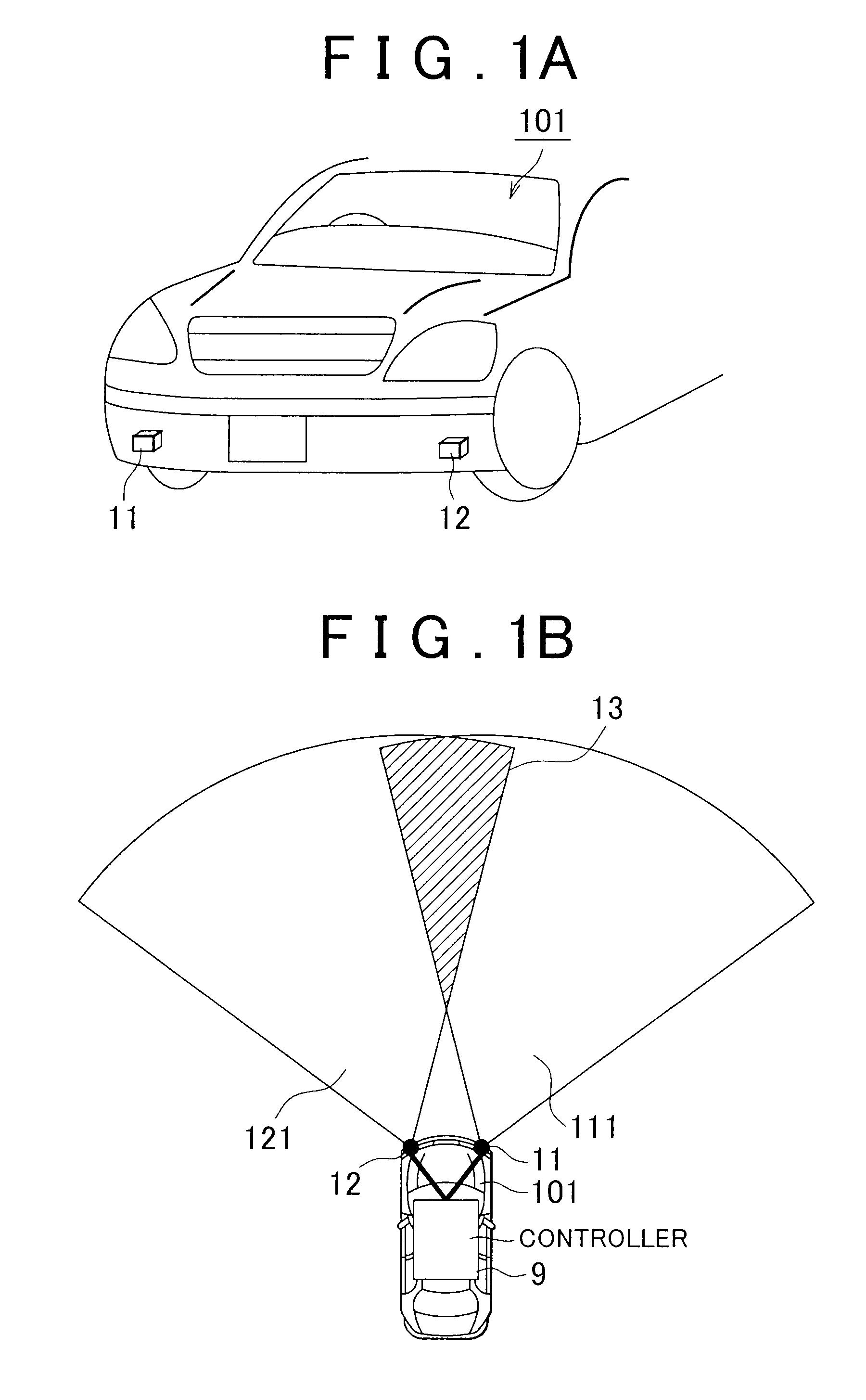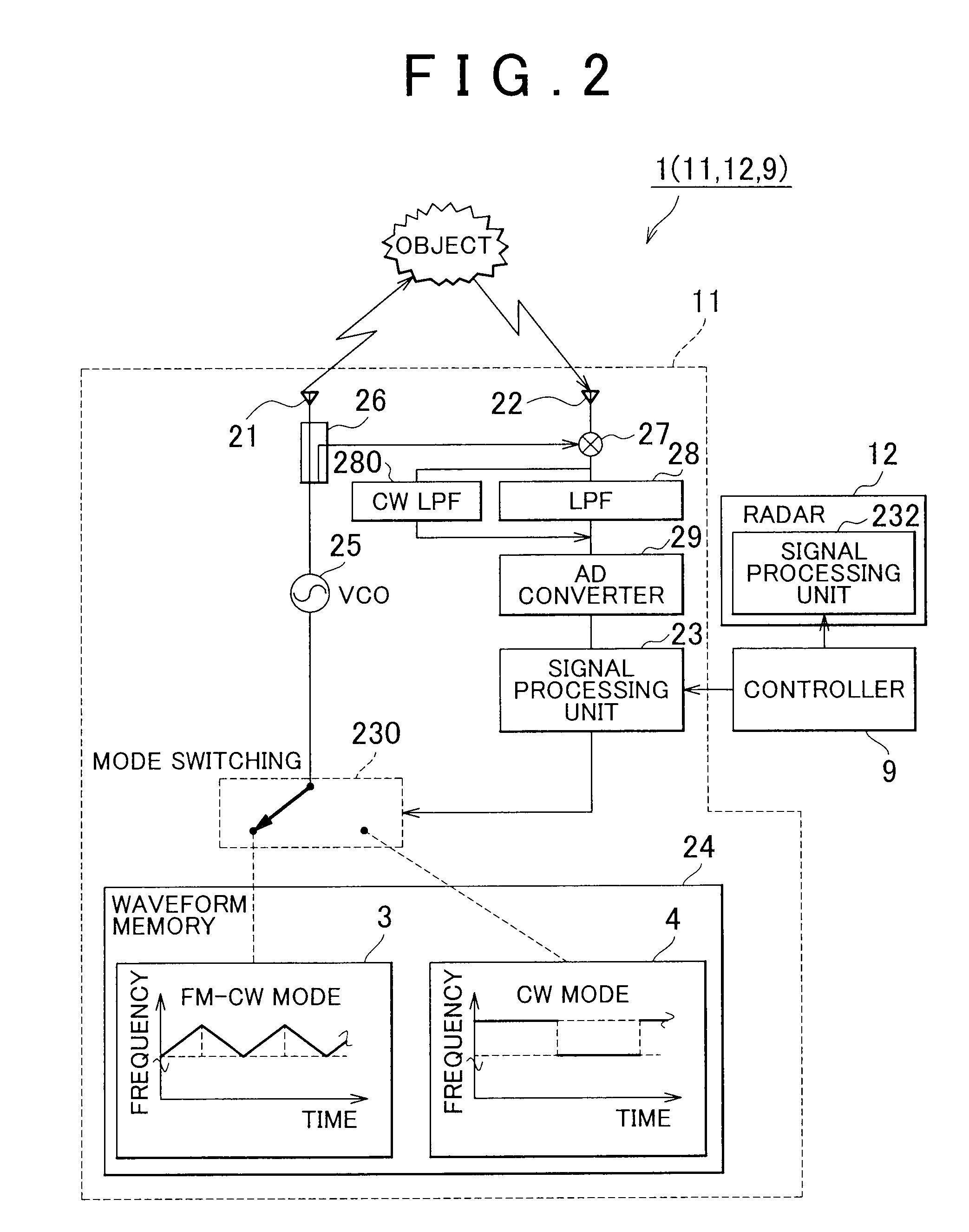Radar system
a radar and system technology, applied in the field of radar systems, can solve the problems of radar not being able to detect a vehicle, radar having a radio wave interference problem with another, and the radar system cannot detect a vehicle, so as to achieve the effect of preventing radio wave interferen
- Summary
- Abstract
- Description
- Claims
- Application Information
AI Technical Summary
Benefits of technology
Problems solved by technology
Method used
Image
Examples
first embodiment
[0041]Hereinafter, a radar system according to the invention will be described with reference to the accompanying drawings.
[0042]FIG. 1A and FIG. 1B are external views of radars according to the first embodiment of the invention. FIG. 1A shows arrangement of the radars as viewed from the front of a vehicle 101. FIG. 1B shows ranges 111 and 112 of detection of the radars 11 and 12 as viewed from the upper side of the vehicle 101.
[0043]As shown in FIG. 1A, the vehicle 101 is equipped with a radar system (which corresponds to a radar system 1 shown in FIG. 2). The radar system includes the plurality of radars 11 and 12 (in this application, when simply referred to a radar, it indicates not the whole radar system but the radar equipped for the radar system). The radar 11 and the radar 12 each output a distance to an object ahead and a relative velocity of the object to an external component. The radars 11 and 12 are, for example, provided at both ends of the front of the vehicle 101. A ...
third embodiment
[0062]Note that it is also applicable that the maximum frequency FFH of the FM-CW mode 3 used in the radar 11 coincides with the maximum frequency of the CW mode 4 used in the radar 12. In this case as well, a similar advantageous effect to that of the third embodiment may be obtained. In addition, both the maximum frequency and minimum frequency of the FM-CW mode 3 used in the radar 11 may respectively coincide with both the maximum frequency and minimum frequency of the CW mode 4 used in the radar 12.
[0063]FIG. 3D shows the fourth embodiment of the frequency modulation patterns of radio waves. Because of the same reason as described in the third embodiment, the fourth embodiment differs from the first embodiment in that the controller 9 causes the minimum value of the frequency band of the FM-CW mode 3 used in the radar 11 to coincide with the maximum value of the frequency band of the CW mode 4 used in the radar 12. With the above configuration, it is possible to reduce the frequ...
sixth embodiment
[0066]FIG. 4B shows the frequency modulation patterns of radio waves. The radar 12 constantly transmits a radio wave. As shown by the waveforms 36 and 46, the controller 9 outputs radio waves in accordance with the following conditions.
[0067]In a time period during which the frequencies (FFL to FFU) output in the FM-CW mode 3 by the radar 11 are higher than a predetermined frequency FM in the middle of the frequencies, the radar 12 outputs a certain frequency FCL (between FFL and FM) that is lower than FM (this is the first condition).
[0068]In a time period during which the frequencies (FFL to FFU) output in the FM-CW mode 3 by the radar 11 are lower than the frequency FM, the radar 12 outputs a certain frequency FCH (between FM and FCH) that is higher than FM (this is the second condition).
[0069]With the above configuration, it is possible to configure the FM-CW mode 3 and the CW mode 4 so that there is no time at which the frequencies coincide with each other. That is, the radars ...
PUM
 Login to View More
Login to View More Abstract
Description
Claims
Application Information
 Login to View More
Login to View More - R&D
- Intellectual Property
- Life Sciences
- Materials
- Tech Scout
- Unparalleled Data Quality
- Higher Quality Content
- 60% Fewer Hallucinations
Browse by: Latest US Patents, China's latest patents, Technical Efficacy Thesaurus, Application Domain, Technology Topic, Popular Technical Reports.
© 2025 PatSnap. All rights reserved.Legal|Privacy policy|Modern Slavery Act Transparency Statement|Sitemap|About US| Contact US: help@patsnap.com



